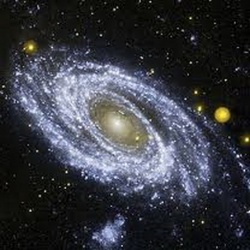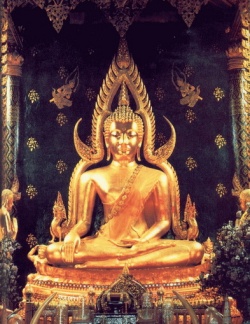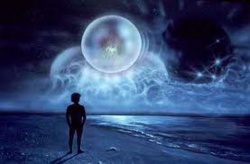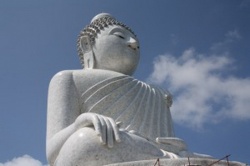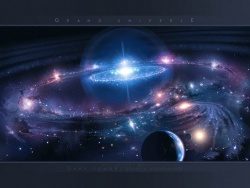Buddhist cosmology by Yin Zhuo
What is cosmology? The dictionary defines it as a branch of philosophy dealing with the origin, processes and structure of the universe.
This may sound like a rather formidible definition, whose exploration has little relevance to the problems we encounter in everyday life. Actually, the opposite is true, since an understanding of the workings of the universe and the cosmic laws that are involved in its unfolding pattern can provide us insignificant humans with precious guidance. If we are wise enough to follow this guidance we may avoid the bad decisions that can lead to undesirable consequences, and instead will be able to make progress toward positive goals during the course of our lives.
Furthermore, because of the infinite wisdom of our Lord Sakyamuni Buddha and his predecessors who appeared on earth long before His time, we are the lucky inheritors of a cosmological tradition of such awesome grandeur that it totally eclipses corresponding conceptions in western religions. Even before the time of Lord Buddha, the Indian sages and thinkers through imagination, the use of super-normal powers and the contemplation of a most ancient wisdom inherited from pre-historic times, managed to arrive at the conception of such a vastness and immeasurability of time and space that for all practical purposes they had arrived at the point of infinity.
The early Buddhist cosmology is geared to stages of spiritual development and the principle of karma. Consequently, there is a gradated universe which combines material and spiritual elements arranged in a hierarchy of increasing spirituality and attainment. The Buddhist universe essentially has 3 levels or planes.
First is the levels of Desire, Form, and Formless. Beyond these three is Nirvana. Within the realm of Desire there is a three-story world involving five paths of rebirth. These range from the lowest-hell to animal, preta (hungry ghosts), humans, and gods. Later Asura, angry spirits or rebel gods, were added, making six.
Beyond the realm of Desire is the World of Form which contains heavens correlated to 4 stages of dhyana (meditation trances) in the Brahma worlds. Altogether there are 17 stages.
Finally, there is the Formless dimension which has four levels. Beyond all these dimensions and levels there is Nirvana which transcends all distinctions and gradations. Altogether there is an infinity of universes reaching the inconceivable totality termed the great thousandfold world or three thousandfold world (1000 X 1000 X 1000 = 1 billion). Every aspect of this cosmology is governed by karma and the level of discipline until one reaches final liberation.
While the historical development is not entirely clear, the Mahayana tradition has added to the general cosmology the concept of Buddha land. Every Buddha has his land or realm as the fruition or fulfillment of his practice. This is represented in his body of fruition or body of reward. The establishment of the concept of Pure Land does not conflict with earlier cosmological concepts but perhaps completes or caps the system.
The Mahayana teachers accepted Early Buddhism as elementary. They also transformed the ideal goal from simply attaining Nirvana to Buddhahood. As a consequence of this alteration there had to be changes in the symbol system leading to the proliferation of Buddhalands and expansion of the Cosmos. While each Buddha had his own Pure Land, the Pure Land of Amida eventually became the most prominent and chief path to achieve Buddhahood for the peoples of East Asia.
Thus, the various Mahayana texts, which narrate the status of the Pure Land and those who enter there, indicate that the Pure Land is beyond the three worlds t or levels - taught by Hinayanists. Some texts state that there are no hells or hungry ghosts, nor the three worlds in the Pure Land. It is a sphere superior to all worlds.
Among the various Pure Lands, individual texts assert the superiority of one land or another. Thus in the Older Kegon text Ch. 29, we are told that one kalpa in Sakyamuni’s land is as one day in Amida’s land. But a kalpa in Amida’s land is one day in the land of Kongobutsu. The series ends with the land of Kenshu Buddha who abides in the Shorengesekai which is filled with many great Bodhisattvas such as Fugen (Samantabhadra) Bodhisattva. The following sections explain some of the concepts and ideas in Buddhism that are taken by most Buddhists as metaphorical or even plain mythological. Nevertheless, these things show up even in the most sophisticated texts, and so the student of Buddhism should be familiar with them—even if they seem at times to take away rather than contribute to the deeper meaning of the Dharma. Westerners are often less comfortable with these things than are easterners, who have grown up with these terms. But a little thought and the reader will recognize that we have very similar concepts in the west, which we use in a similar fashion: Heavens and hells, ghosts and angels, the trinity, the saints.... Whether we take them literally or not, they are a part of how we tell our stories.
The Buddhists, following the traditions of their Indian fore-fathers, saw the universe as infinite in time and space, and filled with an infinite number of worlds like our own.
Above our ordinary world, there are two realms: the realm of form (rupa-dhatu) and the even higher realm of formlessness (arupa-dhatu). Below these is the realm of desire (kama-dhatu) which contains six domains (gatis), each with its own kinds of beings:
1. Devas or gods.
2. Asuras or titans (or jealous gods, or demigods),
3. Manusyas or humans.
4. Tiryaks or animals.
5. Pretas or hungry ghosts.
6. Narakas or demons (hell beings)
All of the above, even the realms of form and formlessness, are in samsara , imperfect existence, and therefore governed by karma and its fruits (vipaka).
Karma is action, and Vipaka, fruit or result, is its reaction.
Just as every object is accompanied by a shadow, even so every volitional activity is inevitably accompanied by its due effect. Karma is like potential seed: Vipaka could be likened to the fruit arising from the tree ?V the effect or result. Anisamsa and Adinaya are the leaves, flowers and so forth that correspond to external differences such as health, sickness and poverty ?V these are inevitable consequences, which happen at the same time. Strictly speaking, both Karma and Vipaka pertain to the mind.
As Karma may be good or bad, so may Vipaka, - the fruit ?V is good or bad. As Karma is mental so Vipaka is mental (of the mind). It is experienced as happiness, bliss, unhappiness or misery, according to the nature of the Karma seed. Anisamsa are the concomitant advantages ?V material things such as prosperity, health and longevity. When Vipaka??s concomitant material things are disadvantageous, they are known as Adinaya, full of wretchedness, and appear as poverty, ugliness, disease, short life-span and so forth.
As we sow, we reap somewhere and sometime, in his life or in a future birth. What we reap today is what we have sown either in the present or in the past.
The world extends around Mount Meru. In the mythology of Tibetan Buddhism, Mount Meru is a place which simultaneously represents the center of the universe and the single-pointedness of mind sought by adepts. Thousands of miles in height, Meru is located somewhere beyond the physical plane of reality, in a realm of perfection and transcendence. Symbolic representations of Mount Meru are commonly found in Tibetan mandalas, contemplative diagrams designed to aid meditators in focusing.
It is said that Meru has its roots in hell, and its summit in heaven. Meru is surrounded by seven rings of golden mountains, each separated from the other by one of seven circular oceans. It is crowned by a golden palace wherein Indra, king of Hindu gods, resides. This entire superstructure rises from an outer ocean, and is flanked by four main continents, each with two subcontinents.
The southern continent, Jambudvipa, corresponds to the physical earth. Each of the other continents represents a nearby planet upon which transmigrating souls following the yellow light-path may be reborn. However, it is said that all of these worlds are undesirable, for they are non-human worlds inhabited by sheep, cattle, or horses. The teachings of Buddhism clearly state that existence as a human being is the only way to achieve Buddhahood, so rebirth in any other form (including that of a deva or demigod) is a distraction from the path to enlightenment.
According to legend, somewhere in the northwest region of Jambudvipa lies a land called Shambhala. This is a magical land which is shaped like an eight-petalled lotus flower. It has been ruled by priest-kings for many thousands of years; in fact, the legend of Shambhala predates the introduction of Buddhism into Tibet. In the aboriginal Bon religion, Shambhala is known as Olmolungrung, and is based on the square instead of the circle.
Shambhala forms a gateway between the physical and spiritual realms. It is endowed with riches, and is ideally suited for the habitat of enlightened souls. They are not attached to the fruits of karma, and are but one step from Buddhahood. This is the realm to be sought for rebirth if one desires the swiftest path to nirvana.
In the Tibetan Buddhist version of the apocalypse, barbarians will overtake the earth at the end of the Kali Yuga, the present age. It will be necessary for the king of Shambhala to join forces with the gods to wage war on the barbarians. At this time, armies will be sent forth from the city, the location of which has been kept secret for millenia. Order will be restored on earth, and the wisdom which Shambhala has been holding will be dispensed to the peoples of the world.
Above the peak is the realm of the Buddha fields (or heavens). On the upper slopes you find the gods. The titans live on the lower slopes. Animals and humans live on the plains around the mountain. Hungry ghosts live on or just below the surface. And hell is deep under the earth. All this is surrounded by a great ocean.
Time in Buddhist cosmology is measured in kalpas. Originally, a kalpa was considered to be 4,320,000 years. Buddhist scholars expanded it with a metaphor: rub a one-mile cube of rock once every hundred years with a piece of silk, until the rock is worn away—and a kalpa still hasna passed! During a kalpa, the world comes into being, exists, is destroyed, and a period of emptiness ensues. Then it all starts again.
Some of the actors in the Buddhist mythological drama include…
Brahma—the supreme deva, who convinced Buddha to teach.
Indra—a major deva, originally the Hindu sky god.
Prajna—goddess of knowledge. Buddha’s mother was considered an incarnation.
Mara—a deva associated with death and hindrances to enlightenment. It was Mara who tempted Buddha under the bodhi tree.
Yama—the king of the 21 hells (see image above).
Nagas—great serpents (or dragons, or water creatures). The king of the Nagas protected Buddha from a storm.
Gandharvas—angelic beings who provide the gods with music
In Mahayana and especially Vajrayana, the idea of the Buddha and his Dharma evolved into a more elaborate system called the Trikaya, or three bodies of Buddha:
1. Nirmanakaya—The earthly Buddhas (and Bodhisattvas), especially as personified by Siddhartha Gautama. In Tibet, the intentional human embodiment of a reborn master.
2. Sambhogakaya—Buddhas in their heavens, the result of accumulated merit. Or, in Zen, enlightenment. In Tibetan buddhism, this refers to the means of achieving the Dharmakaya, i.e. the power of meditation on the various visualized dieties called yidams which are archetypal symbols of different qualities of enlightenment.
3. Dharmakaya—The teachings of the Buddha, and the true nature of the Buddha, which is everything. Buddha mind, or Shunyata.
In Tibet, they also refer to the body, speech, and mind of a master. And they are represented by the mudra, the mantra, and the mandala, respectively.
Resources
Rev. Tri Ratna Priya Karuna Dharma talk on Buddhist Cosmology
Snelling, John (1991). The Buddhist Handbook. Rochester, VT: Inner Traditions.
Rahula, Walpola (1959). What the Buddha Taught. NY: Grove Press.
Gard, Richard (1962). Buddhism. NY: George Braziller.
